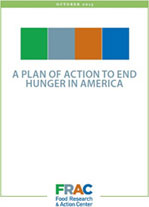Published on January 17, 2025
House Budget Committee Chairman Jodey Arrington (R-TX) has put out a list of proposals for budget reconciliation, which includes $12 billion in cuts to school breakfast and lunch. The proposals would dramatically reduce the number of schools able to offer free meals to all their students and impose significant and burdensome school meal paperwork requirements that would limit access to free and reduced-price school meals in non-Community Eligibility Provision (CEP) schools.
CEP allows high-need schools to offer breakfast and lunch to all their students at no charge, and the proposal would make more than 24,000 schools across the country, serving more than 12 million children, no longer eligible to participate in CEP. The table below details the impact of the proposal by state.
CEP dramatically reduces administrative work for schools by eliminating the need for school food service departments to process school meal forms, and to no longer deal with school meal debt. Rather than using individual student eligibility to determine the school meal reimbursements, CEP schools are reimbursed based on their percentage of poverty, as determined by students’ participation in other means-tested programs, such as the Supplemental Nutrition Assistance Program (SNAP), Temporary Assistance for Needy Families (TANF), and in many states, Medicaid. Currently, schools qualify if 25 percent of students receive these benefits (called identified students). This is a subset of the number of children who are eligible for free or reduced-price school meals, since more students would be certified through the school meal application process. The proposal would increase the eligibility threshold from 25 percent to 60.
Taking away this important and effective way for local schools to offer breakfast and lunch at no charge to all of their students would increase hunger in the classroom, reintroduce unnecessary paperwork for families and schools, increase school meal debt, and bring stigma back into the cafeteria. Schools should continue to have the choice to participate in CEP, which ensures that all students have access to nutritious school breakfasts and lunches that fuel their health and learning.
The Chairman’s proposal would also require all families who apply and are approved for free and reduced-price meals at non-CEP schools to document their household income when they submit their school meal application. Many eligible children would lose access to free and reduced-price school meals, and the administrative burden on schools to process school meal applications would dramatically increase. This change is estimated to reduce the cost of school meals by $9 billion dollars.
Ensuring that students are well-fed is part of safeguarding the health and well-being of our country’s children, which is essential to our national security. While participation in CEP has increased tremendously over the last decade, financial barriers preventing many eligible schools from participating remain. Congress should be working to strengthen and expand CEP so all eligible schools can benefit, not reducing the number of schools that qualify.
| State | Number of Schools Affected | Number of Children Affected |
|---|---|---|
| Alabama | 202 | 100,290 |
| Alaska | 102 | 19,066 |
| Arizona | 366 | 148,062 |
| Arkansas | 196 | 82,364 |
| California | 4,091 | 2,452,931 |
| Colorado | 557 | 206,293 |
| Connecticut | 262 | 128,388 |
| Delaware | 129 | 64,741 |
| District of Columbia | 41 | 15,251 |
| Florida | 1,175 | 1,014,942 |
| Georgia | 501 | 320,818 |
| Hawaii | 52 | 27,018 |
| Idaho | 54 | 20,555 |
| Illinois | 140 | 80,636 |
| Indiana | 284 | 122,769 |
| Iowa | 124 | 68,296 |
| Kansas | 76 | 27,711 |
| Kentucky | 631 | 360,485 |
| Louisiana | 469 | 253,062 |
| Maine | 75 | 21,884 |
| Maryland | 393 | 251,318 |
| Massachusetts | 469 | 221,477 |
| Michigan | 1,327 | 503,793 |
| Minnesota | 204 | 87,503 |
| Mississippi | 119 | 55,376 |
| Missouri | 247 | 80,124 |
| Montana | 75 | 10,142 |
| Nebraska | 49 | 12,432 |
| Nevada | 484 | 348,192 |
| New Hampshire | 4 | 727 |
| New Jersey | 227 | 93,251 |
| New Mexico | 665 | 216,669 |
| New York | 1,784 | 908,567 |
| North Carolina | 794 | 408,887 |
| North Dakota | 15 | 3,954 |
| Ohio | 728 | 287,362 |
| Oklahoma | 311 | 102,194 |
| Oregon | 707 | 285,272 |
| Pennsylvania | 666 | 320,262 |
| Rhode Island | 73 | 36,263 |
| South Carolina | 351 | 246,009 |
| South Dakota | 37 | 7,600 |
| Tennessee | 598 | 280,726 |
| Texas | 1,711 | 974,497 |
| Utah | 57 | 24,964 |
| Vermont | 188 | 47,153 |
| Virginia | 784 | 451,117 |
| Washington | 987 | 465,853 |
| West Virginia | 468 | 182,745 |
| Wisconsin | 309 | 107,541 |
| Wyoming | 17 | 2,024 |
| U.S. Total | 24,559 | 12,473,887 |
This data reflects Community Eligibility participation as reported by state agencies for the 2023-2024 school year.
Source: Food Research & Action Center. (2024). Eligibility for Community Eligibility Provision Database. https://frac.org/community-eligibility-database/


